Abstract
This article provides an extensive examination of the interconnectedness between energy and water in island regions, particularly those heavily reliant on tourism, as exemplified by the present case. This study explores the present state and trends of research in this field with the objective of attaining a sustainable system in future scenarios. Specifically, this analysis delves into the water–energy–CO2 nexus of the Colombian island of San Andrés. Currently, there is no energy generation from the water sector, with 76.18% of water consumption directed towards the cooling of thermal power plants and a mere 1.54% of the energy employed for water extraction, desalination, and purification. In 2019, the island’s total energy consumption reached 138 ktoe (kilotons of oil equivalent), and renewable energies have yet to contribute to the system. These findings emphasize the necessity for the island to implement measures that will bolster its sustainability, self-sufficiency, and resilience. This entails mitigating and managing the intensity of resource consumption, particularly in areas experiencing economic growth. According to the Sankey diagram obtained, some political implications and recommendations have been listed.
1. Introduction
Climate change is a global concern that was highlighted at the United Nations Climate Change Conference. Adapting and reducing our vulnerability to climate change is crucial, with overarching goals outlined in their Sustainable Development Goals. Regional impacts vary, but emerging countries and islands face significant consequences, including the risk of island disappearance [1]. Island territories face significant challenges in the coming years, including the need to enhance sustainable solutions for resilience and energy independence. These regions are particularly vulnerable to climate fluctuations due to their limited land area, low elevation, scarce resources, and vulnerabilities related to food, water, and energy availability [2,3]. Coastal water pollution and heatwaves further contribute to their vulnerability [4]. For example, Kiribati, Fiji, the Maldives, Micronesia, Cape Verde, and the Solomon Islands are at risk of becoming uninhabitable due to rising sea levels, coastal erosion, and territorial loss. Urgent action is required to address these issues and ensure the long-term sustainability of island regions [2,4]. Islands face resource constraints, environmental degradation, and population pressures, posing a complex survival challenge for communities and economies [5,6]. Efforts in island management aim to mitigate global warming by managing electricity, transportation, water, and energy consumption to reduce CO2 emissions [7,8,9,10]. A holistic approach integrating the water and energy sectors is crucial for sustainable and efficient resource management in island territories. Island territories, such as Puerto Rico, Haiti, and the Dominican Republic, are among the most affected by climate change [11]. Additionally, countries in the Caribbean region, including Colombia, Honduras, and Nicaragua, face significant impacts, particularly from extreme weather events such as hurricanes, despite not being classified as islands [12].
In this context, the current investigation is centered on Colombia, specifically the San Andrés Island [13], situated in the Caribbean region. San Andrés is located approximately 290 km off the coast of Nicaragua, and 480 km from the coast of Cartagena (Colombia), as depicted in Figure 1. San Andrés is a paradisiacal island renowned for its iconic marine biodiversity and strategic ecosystems. It boasts a rich array of endemic species and experiences minimal anthropogenic influence. Often referred to as the “Island of Seven Colors,” it stands as one of the Caribbean Sea’s most sought-after diving destinations. Notably, this island is encompassed within Seaflower, designated a biosphere reserve in 2000 under UNESCO’s “Man and Biosphere” program. Its coral reefs span approximately 5% of the Caribbean Sea and account for 76% of Colombia’s coral reef coverage. It is the first reserve of its kind in the country and the largest in Colombia and the Caribbean, ranking eighth globally. Encompassing an expansive area of 65,000 km2, the reserve safeguards over 2000 km2 of mangroves, seagrass beds, and coral reefs, which support a diverse range of marine biodiversity [14,15].
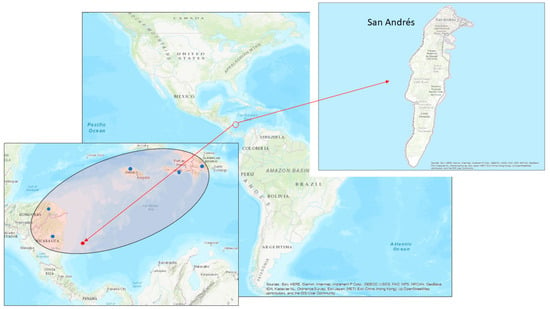
Figure 1.
Climate change risk zone and spatial distribution of San Andrés Island, Colombia. In red, the location of the island.
Colombia comprises 32 geographic political divisions known as departments. The archipelago of San Andrés, Providencia, and Santa Catalina is the only group of islands within the country, forming the Department of San Andrés and Providencia. It should be noted that this department is not part of the National Interconnected System and, therefore, is considered a region of the non-interconnected zones of Colombia [16]. San Andrés Island is the capital of the department, and it is located between 12º29′58′′ and 12º35′55′′ N and 81º40′49′′ and 81º43′23′′ W, with an area of 32 km2, a population of 55,291 inhabitants, and an average annual tourism of 845,910 tourists [17]. Around 72–75% of the population is concentrated in the urban perimeter on the north of the island, where most hotels and annual commerce are also located. This island is considered one of the most populated in the Caribbean, with a population density of 2524.11/km2, and its economy depends primarily on tourism and secondarily on fishing-based commerce [17]. Regarding recent energy policies, Colombia has been implementing policies since 2014 with the objective of promoting an increased adoption of renewable energy in both the national interconnected system (NIS) and non-interconnected zones (NIZ) across the country. These policies are designed to diversify the energy matrix, foment the development of hydroelectric projects, promote energy efficiency, strengthen the electricity sector, and support research and technological advancements. These goals have been supported by legislative measures, such as Law 1715 of 2014 and Law 2099 of 2021, along with their corresponding regulations, which have played a crucial role in driving progress toward these objectives [18,19].
San Andrés Island has been chosen as a case study primarily due to several key characteristics, including (i) challenges in providing electricity access in rural areas; (ii) elevated costs associated with electricity provision, primarily driven by a reliance on fossil fuels (specifically, diesel); and (iii) the significant financial burden and transportation expenses resulting from diesel subsidies for power generation [16,20]. Concerning the water sector, San Andrés faces a substantial deficit in potable water, with a demand exceeding its supply due to the overexploitation of underground resources [21]. Moreover, there is a lack of up-to-date information that could inform innovative approaches aimed at enhancing resilience in the foreseeable future. Building upon the aforementioned factors, this study examines the existing technical framework within the water–energy nexus, considering the various economic sectors of the island. This analysis serves as a tool for ensuring the sustainability of the region and as a model for other Caribbean islands that share similar characteristics.
The purpose of this research was to conduct a comprehensive analysis of the correlation between water and energy resources on the island of San Andrés and, likewise, to gain an in-depth understanding of the water and energy supply and demand across various sectors, including residential, commercial, tourism, agriculture, and transportation. To accomplish this, an investigation was conducted into the water supply, utilizing sources such as rainwater harvesting, groundwater extraction, and desalination. Additionally, water consumption in each sector was analyzed. Furthermore, a thorough examination of the current energy generation system, which relies solely on fossil fuels, was undertaken. The aim was to calculate the energy demand and consumption in different sectors while evaluating energy losses within the system. Moreover, this study seeks to identify potential solutions and offer recommendations for enhancing the efficiency of water and energy usage on the island. The results obtained will inform the development of viable and substantiated proposals to optimize resource utilization on the island of San Andrés, thereby promoting sustainability and reducing its reliance on fossil fuels.
This paper is structured as follows: Section 1 highlights the significance of studying the water–energy nexus in isolated areas of the Caribbean, with a specific focus on San Andrés Island. Section 2 is divided into three parts: (i) the current socio-demographics and economic context; (ii) a comprehensive review of the island’s water and energy resources, presenting their status; and (iii) the methodology employed for data collection and the establishment of water–energy interrelationships. In Section 3, a diagram is presented to visually illustrate the gathered information. Section 4 and Section 5 offer a brief discussion and analysis, while the final section presents the conclusions.
2. Data Resource and Methods
2.1. Water and Energy Resources
The primary water transportation channel on the island is an aqueduct that traverses the San Andrés Island from north to south. However, its current capacity is insufficient to adequately meet the needs of the inhabitants. Presently, the water supply system relies on rainwater harvesting, groundwater extraction, and more recently, desalination. Additionally, the hotel sector typically constructs wells to obtain fresh water, and the population that does not have access to the aqueduct system purchases water. In this scenario, water is transported to end users via tanker trucks from storage systems in rainwater tanks, as well as small-scale desalination systems, among other methods [17,22,23]
Influenced by precipitation patterns and effective recharge, groundwater originates from two primary aquifers: i. the San Andrés aquifer, situated in the central region of the island and primarily providing water to the aqueduct; and ii. the San Luis Aquifer, located on the lower part of the island and serving as the main water source for the population residing in the center sector, named “North End”. Recharge occurs through rainfall, water from the San Andrés aquifer, and wastewater from septic tanks, which frequently leads to aquifer contamination [24].
Meanwhile, rainwater harvesting and desalination serve as alternative water supply mechanisms for the population that is covered by the main aqueduct system, alongside domestic wells and private mini-desalination plants, as depicted in Figure 2.
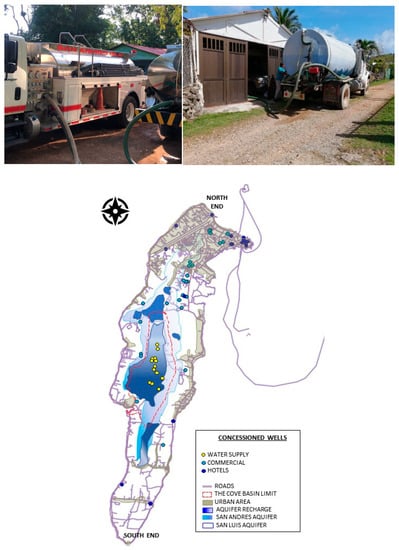
Figure 2.
Geographical distribution of concession wells on San Andrés. Data obtained from [25].
Due to the limitations of the aqueduct network, as stated in [26], around 60.38% of the surveyed households, out of 13,977, rely on bottled water or purchase bagged water for cooking. Additionally, 13.57% utilize rainwater, 11.64% rely on wells equipped with a pump, 10.22% use water from the public aqueduct for cooking purposes, 3.01% depend on water supplied by tank trucks, and 1.17% use wells without a pump.
The energy generation system relies on conventional and highly polluting technologies, as the entire electricity demand is met through the combustion of fossil fuels by DieselGen (the diesel generation plant). The provision, operation, exploitation, and distribution of electric power are managed by the private operator Sociedad Productora de Energía de San Andrés y Providencia S.A. ESP-SOPESA S.A., which has held the concession from the Ministry of Mines and Energy since 2009, or for a duration of 20 years. Currently, San Andrés has an installed capacity of 83.67 MW, distributed among 18 diesel-operated generation units [27]. The 18 generator sets are from the manufacturers MB, EMD, and MAN, with powers ranging from 2.1 MW to 14.3 MW. Descriptions of the diesel turbines up to the year 2018 can be seen in [28]. The liquid fuel used is transported by sea from the Ecopetrol power plant in Cartagena de Indias, located on the Caribbean coast of Colombia, to the island, which is approximately 720 km away. The transportation process takes approximately 3 days [25].
2.2. Methods
The methodology employed to examine the correlation between water and energy is illustrated in Figure 3. The initial assessment entails the identification of resource availability, followed by the determination of demand and ultimate utilization. The demand for water and energy is segmented across various sectors, namely residential, commercial, tourism, agriculture, and transportation. The end-of-use phase shows the final disposition of the resources, water or energy.
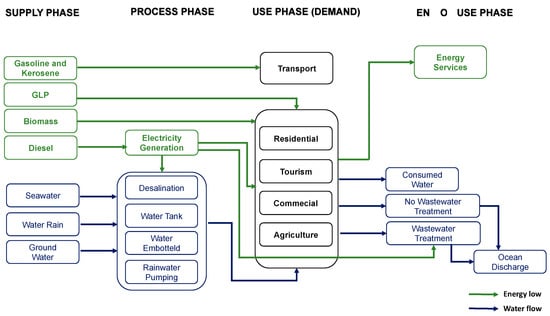
Figure 3.
Integrated energy–water flow diagram for San Andrés Island.
2.2.1. Supply Phase Analysis
This initial phase entails assessing the acquisition of the primary resource. Currently, there is no publicly available document specifying the actual water demand of the population. In order to estimate freshwater demand, population figures from 2012 to 2019 were initially extrapolated [17]. Secondly, the water consumption per resident (100 L/s) and tourist (323 L/s) was considered [23]. With these data, an estimation of the drinking water demand for the year 2019 was derived.
For the quantification of the population in the year of study (2019), an exponential method was used based on the information obtained from [22]. The water demand for the year 2019 was determined for each water source, namely rainwater , seawater , and groundwater . To calculate the rainwater harvested in Hm3, we utilized an equation for rainwater collection. In the equation, Vc represents the volume of water to be collected in m3, denotes the annual rainfall (1496 mm) [17], represents the area of the canopy used for collection (4955 m2) and Fa represents the utilization factor, which is 0.85 [27]. This is represented by Equation (1).
The annual volume of the plant was estimated by extrapolating trends observed over the years, resulting in an approximate volume of 3.54 Hm3 for the year 2019.
The groundwater , which is the most significant water resource on the island, was estimated based on the licensed and extracted volumes from each sector/distribution mechanism, extrapolated to the year 2019 [23]. In terms of groundwater distribution, 67% was utilized by households through cisterns, deep wells, and bored wells. The aqueduct system accounted for 30% of the extraction, while the remaining water was obtained through bottling and tanker truck sales. Table 1 shows the percentage of drinking water according to source.

Table 1.
Summary of the primary water sources available for the population’s consumption on the island.
Regarding the primary fossil resource, data were directly obtained from multiple sources [17,29,30,31,32]. These data were processed and extrapolated to the year 2019 to provide an approximation of the current demand context.
Fossil fuel demand by sector is primarily determined by the main resources. The distribution of demand and energy systems can be categorized as follows: i. gasoline, predominantly used in the transportation sector with a focus on road transport and a smaller portion for maritime transportation; ii. diesel oil, primarily utilized in land transport and, to a minor extent, in the maritime sector, particularly for fishing vessels; iii. kerosene, exclusively employed in air transportation; iv. diesel, predominantly used for power generation in thermal power plants and, to a limited extent, in maritime transportation (fishing and coastal shipping); v. biomass, solely utilized in the residential sector; and vi. LPG (liquefied petroleum gas), utilized in transportation, residential, and industrial sectors due to its versatility. Figure 4 represents the different types of transport present on San Andrés Island, with their respective data. The transport has been divided into road transport, fishing transport, and maritime transport for cabotage. The blue and green bars represent the types of fuel, where the left y-axis indicates the fuel quantity, expressed in millions of gallons. The red line, linked to the right y-axis, represents the number of vehicles for each type of transport.
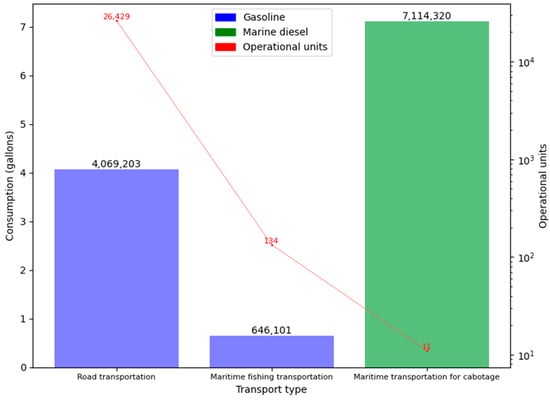
Figure 4.
Fossil fuel consumption in the transportation sector. Data extracted from [33].
2.2.2. Process and Demand Phase
Water demand by sector:
To calculate the total amount of water consumed ( in each sector, Equation (1) was applied,
where represents the total water demand per sector in Hm3, and denotes the ratio of water consumed to water demand for sector i, obtained from [34].
The water demand in the production of electricity, which is used in the cooling of the diesel generation plants, was estimated according to [35]. This estimation was based on the quantity of fossil fuels consumed by the diesel generation plant and the corresponding electricity production.
Figure 5 shows the water demand by sector. The highest losses were observed in the primary water resources of groundwater extraction and seawater extraction. Rainwater is a crucial resource for the islanders, as it is the main water source for the population. It is worth noting that the aqueduct system on the island suffers from adequate infrastructure and lacks proper maintenance, resulting in a deficit in the total network coverage. Fortunately, losses in rainwater are nearly non-existent since it is naturally distributed.
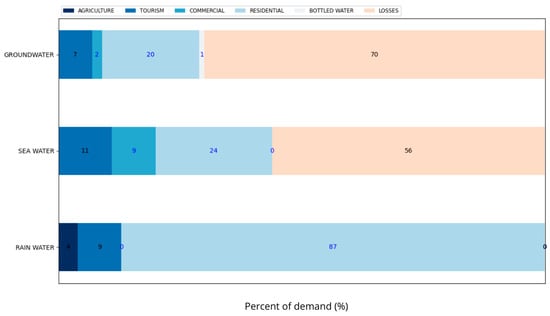
Figure 5.
Final water consumption aggregated by sector for 2019.
Electricity demand by sector:
During the study year (2019), the demand for electricity witnessed a 7.5% increase compared to 2013 (the last year of reliable data), amounting to approximately 213 GWh/year [30,36,37,38]. The electricity demand was evaluated in the different sectors (residential, tourism, commercial, and industrial). This evaluation was obtained directly from [29], where 35% corresponds to the residential sector, followed by the tourism sector with 21% and the commercial sector with 18%. Additionally, 26% represents the electricity demand in other sectors, such as public roads and official sectors, among others (Figure 6).
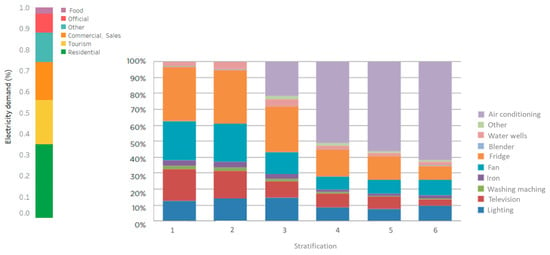
Figure 6.
Electricity demand by sector in 2019.
Colombia has a classification system for residential properties called socioeconomic stratification, which groups the properties into six (6) classes according to the income that its population receives, where stratum one (1) is the lowest income stratum. The objective is for households with lower incomes to be subsidized in basic services (water and sewage, electricity, and natural gas) by households with higher incomes [39]. San Andrés, being the capital island, has a diverse distribution of households. Approximately 30% of the households do not fall within a specific stratum classification. About 48% of households belong to stratum 1 and 2, while 21% are classified under stratum 3 and 4. A minimal percentage of 1% represents households classified as stratum 6 [40]. Figure 6 illustrates the electricity consumption of the sectors under investigation by stratum from (1) to (6), focusing on household appliances. In this context, the commercial and hotel sectors exhibit a higher demand for air conditioning, followed by refrigeration and ventilation. In the residential sector, the greatest electricity demand is attributed to the extraction of fresh water through the use of water pumps.
The electricity consumption in processes related to water production and distribution was calculated using the methodology described in [34]. The primary energy-intensive processes involved in water management include (i) desalination plants for treating brackish and seawater, (ii) wastewater treatment plants, (iii) wells, and (iv) aqueduct network distribution. Table 2 shows the average energy consumption for each of these processes, derived from values obtained from [34].

Table 2.
Average specific energy consumption by water processes. Source: [34].
Figure 7 illustrates the specific level of demand for each fossil resource, which is allocated among the transportation systems and the sectors directly utilizing these resources.
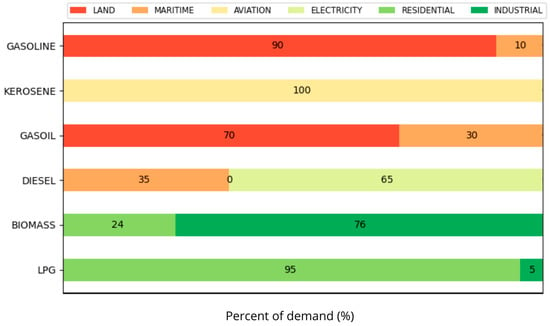
Figure 7.
Final fuel consumption by sector in 2019.
2.2.3. Final Use Phase
The final water usage and its losses can be estimated in a similar manner to energy. Once water is supplied to a specific sector, it can be either consumed (i.e., leave the water system) or returned to the natural resource through the sewerage system. However, it should be noted that, on San Andrés, only a small portion of the population is connected to the sewage system, and there is no pretreatment of wastewater before its discharge into the ocean.
Accordingly, water that is not consumed is referred to as wastewater or generated water . This water follows differing paths and, thus, has differing final uses on the island: (i) A significant portion, approximately 87.90%, of the total water used in the residential, commercial, and tourism sectors is discharged into the ground through systems such as septic tanks. This method is the most popular alternative among the islanders. (ii) Approximately 4.10% of the total wastewater is discharged into latrines. (iii) A small percentage, approximately 0.40% of the total wastewater, is discharged into the ocean without prior treatment through pipelines. (iv) There is a wastewater treatment system with very low coverage, located only in the North End sector, which connects only 28% of the homes, representing a limited option for wastewater disposal.
This discharge is primarily attributed to hotel facilities, accounting for approximately 7.5% of the total generated water [41]. The calculation of wastewater or generated water was conducted for each sector i and every street, expressed in hectometers cubed Hm3, according to Equation (4):
where is the demanded water, defined in Equation (2), and is the ratio of the wasted water by sector. This equation was used in order to obtain the wastewater for each sector and each final use .
In relation to water losses, San Andrés faces several water resource challenges, including the following: i. non-compliance with the tariff structure established by the Drinking Water and Basic Sanitation Regulatory Commission (CRA), ii. illicit connections to the aqueduct system, iii. inadequate system maintenance leading to water loss during transport, and iv. limited environmental awareness and an absence of cost-saving practices. Groundwater extraction represents 70% of the total water supply, while desalination accounts for 55.86% [22].
The final energy use of each sector and the dissipated energy were calculated by incorporating the efficiency and loss coefficients specific to each sector. The objective was to calculate the dissipated energy, , and the final energy, .
The dissipated energy was calculated by subtracting the final energy use from the total energy demand, as shown in Equation (5):
where is the annual energy use, in ktoe, for each sector i, and denotes the annual energy demand, in ktoe, for sector i. The calculation was performed by segmenting each sector based on the obtained data [34]. The data for the electricity sector were obtained from [42], which provides information on island’s annual fuel consumption. Furthermore, the electricity production data can be found in references [30] and [37]. Considering that the archipelago’s electricity matrix relies solely on fossil fuels, the total dissipated energy in the electricity sector is determined using Equation (6):
where represents the sum of the energy derived from the various fuels used in electricity production, expressed in ktoe, and, additionally, signifies the system losses, which account for more than 24% of the total electricity injected into the grid [27]. These losses are primarily attributed to electricity transportation and distribution processes.
2.3. Green House Gas (GHG) Emissions
According to the National and Departmental Inventory of Greenhouse Gases in Colombia, the San Andrés Island emitted 304 kt CO2 eq in 2012 [42,43]. For the calculation of emissions in the base year, emissions were indirectly considered according to population, resulting in total emissions of 484 kt CO2 eq, where the percentage distribution of emissions by sector is shown in Figure 8.
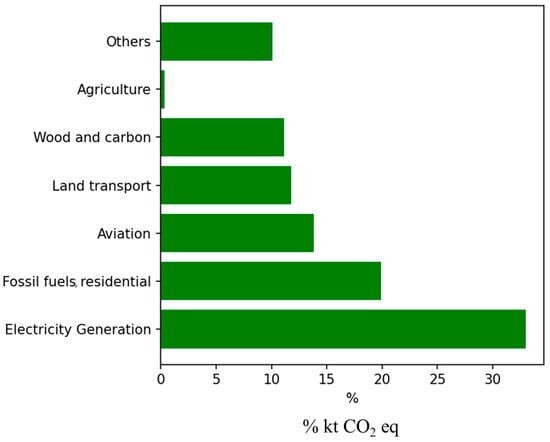
Figure 8.
Emissions by sector in 2019.
Due to the emissions generated during electricity generation and consumption, these emissions can be shared between different sectors based on their respective electricity demand. As outlined in [34], the emissions for each sector, , can be determined using Equation (7):
where is the demand of the electricity sector , in ktoe, and is the annual average specific emissions generated from the electric power system, in kt CO2 eq. The estimate for the total emissions of each sector, in total, was obtained in accordance with the methodology applied in [34].
3. Results
This section presents an analysis of the Sankey diagram (water–energy interaction) shown in Figure 9, depicting the flow of water and energy resources on the island of San Andrés in 2019. The diagram provides a visual representation of the different sectors studied, illustrating the distribution of resources, proportional consumption, losses, and greenhouse gas (GHG) emissions. The energy flow is shown in green ranges, while the water flow is represented in blue ranges. The value indicated in each box represents the estimated resource demand, expressed in ktoe/year for the energy sector and in Hm3/year for the water sector. The red arrows indicate water losses, and the horizontal orange boxes display the calculated GHG emissions, in kt CO2 eq.
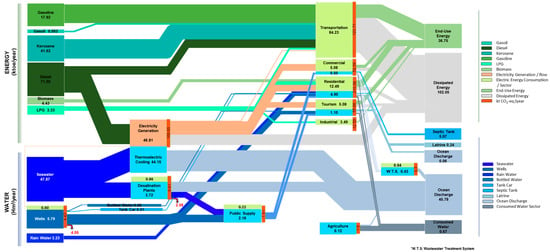
Figure 9.
Energy–water–CO2 nexus of the island of San Andrés in 2019. The red boxes to the right of some sectors represent the calculated emissions of the sector.
3.1. Water Results
The analysis revealed that the primary sources of water for the San Andrés Island are categorized as subterranean wells (cisterns, deep wells, and bored wells), representing 45.42% of the total water supply; seawater, representing 29.22%; and rainwater, representing 25.36%. The seawater extracted for cooling thermal power plants represents 92.22% of the seawater, and the rest is dedicated to residential use.
From the Sankey diagram, the residential sector is revealed as the largest consumer of water, followed by the tourism sector. Additionally, the Sankey diagram reveals that a significant portion of the population’s wastewater is disposed of in septic tanks (87.46%), leading to the contamination of the island’s drinking water.
However, considering the actual losses in water extraction and transport, the main freshwater sources for the islanders are rainwater, with a total value of 48.88%, seawater, representing 24.85%, and wells, with a value of 26.27%, discounting the losses in the water extraction and transport.
3.2. Energy Results
The transport sector accounts for the highest energy demand, followed by the residential, tourism, and commercial sectors, and, finally, the water sector. In terms of electricity consumption, the residential sector represents 40.90% of the total electricity usage on the island, while the commercial and industrial sectors each contribute 25.26%. As for the water sector, desalination consumes 4.30% of the energy supply, followed by pumping with 2.97%. Water treatment has a relatively lower energy demand.
3.3. CO2 Emmisions
Figure 9 reveals the total emissions, amounting to 627 kt CO2. The primary sources of these emissions are thermal power plants, which account for the highest contribution, followed by the residential and transportation sectors.
4. Policy Implications
Isolated territories present additional challenges in environmental, economic, and social aspects. Currently, San Andrés faces significant challenges due to inefficiencies in its infrastructure, with underground wells experiencing losses of up to 70% and seawater treatment losses reaching 56% (Figure 9). This situation has environmental impacts, leading to significant annual emissions in kt CO2-eq. (Figure 9). Urgent action is required to address these challenges, including the implementation of regulations for hybrid renewable systems, the integration of electric vehicles, and the exploration of solar energy solutions. It is crucial to note that the regulations governing these solutions should be distinct from the general Colombian regulations, and specific regulations for the NIZ are necessary. An important case would be the application of Law 1964 of 2019, on sustainable mobility, in San Andrés [44].
Water contamination is primarily attributed to the improper disposal of wastewater in septic tanks. To address this issue, prioritizing infrastructure investment is critical within public policies concerning environmental impact. Furthermore, informative campaigns targeting the local population must be implemented, accompanied by the establishment of stringent regulations in the commercial sector to govern proper wastewater disposal. In addition to wastewater contamination, the proper disposal of solid waste is also a significant challenge within the SEAFLOW reserve, posing risks to water resources and overall environmental sustainability [14]. Understanding the influence of climate changes, such as the El Niño phenomenon, on hydroelectric generation and water availability is crucial for developing policies that enhance resilience to climate change. Moreover, the findings of this study hold direct significance for the sustainable development of tourism on the island of San Andrés. The availability and quality of water and energy resources play a pivotal role in ensuring a high-quality tourist experience and preserving the natural environment. Hence, policies should encompass the necessity for adequate infrastructure, effective resource management, and the promotion of sustainable practices within the tourism sector.
Finally, the policies pertaining to San Andrés Island should prioritize regional development over national development. These policies can be associated with Laws 1715, 2099, and 1964; however, they must be regulated considering three key aspects: i. San Andrés is an island territory that is disconnected from the Colombian electricity grid; ii. it is a territory characterized by its abundant biodiversity, declared as a heritage for all of humanity; iii. it is an area with significant value and a high potential for tourism.
Considering these three key aspects and Colombia’s commitments to the United Nations, outlined in its nationally determined contribution (NDC), a comprehensive analysis was carried out to examine a scenario in which select objectives for the year 2030 can be accomplished by the year under investigation, 2019. The main points are:
- Colombia aims to achieve a 30% share of non-conventional renewable energy in its energy matrix by the year 2030. Considering the specific case of San Andrés, where 46.81 ktoe/year of energy currently comes from fossil fuels (Figure 9), a 30% reduction in this reliance through the adoption of non-conventional renewable energies, such as solar and wind power, would result in a diesel reduction of 14.04 ktoe/year. This reduction in fossil fuel consumption would lead to a significant decrease in emissions, which would be, per our estimations, 28.19% lower than the current levels. The tourism and commercial sectors would be the most benefited, with 20.25% and 19.52% fewer emissions, respectively.
- In a more ambitious scenario (the transforming energy scenario, TES), considering 100% renewables, some interesting results were obtained as follows: The emissions from electricity generation would be reduced to 10.23 kt CO2-eq. The most benefited sectors would be commercial and tourism, with a reduction of 65.1% and 67.45% in their emissions, respectively.
- On the other hand, irrespective of the aforementioned scenarios, the implementation of a fiscal roadmap committed to promoting energy efficiency and reducing energy consumption by 10% through targeted tax incentives and regulations demonstrates positive outcomes. The case study revealed that applying this reduction strategy across the commercial, residential, tourism, and industrial sectors would result in a 3.68% decrease in emissions for the analyzed year, as illustrated in Figure 9.
- Finally, considering the projected operation of 600,000 electric vehicles in Colombia by the year 2030 and based on the census population, it is estimated that San Andrés would require 755 electric vehicles to meet the country’s commitments. According to [32], San Andrés had a total of 26,436 vehicles of various types in use during the study year, indicating that 755 electric vehicles would only represent 3%. However, considering a more ambitious scenario, such as the TES model, and given that San Andrés is a biosphere reserve region, the implementation of 20% electric mobility would result in a 2.5% increase in emissions. This is primarily due to the island’s heavy reliance on diesel power plants for electricity generation in addition to losses in electric transport. If San Andrés intends to establish an electric vehicle fleet with these characteristics, it would be necessary to install renewable energy sources representing at least 10.4% of the total generation capacity to ensure an 80% daily charging availability for the electric vehicles.
Some additional recommendations, based on the analysis and context of the island, may include the following:
- Establishing regulations and standards for the sustainable development of tourism, promoting environmentally friendly practices, and engaging local communities in decision-making processes.
- Encouraging research and development activities and investing in project financing, pilots, and programs that foster regional innovation. This will facilitate the development of efficient and environmentally friendly solutions tailored to local needs.
- Prioritizing the development of drinking water and sanitation infrastructure, particularly in improving wastewater treatment and ensuring proper management of septic tanks. This is essential for reducing pollution and preserving water resources. Strict regulations should be enforced to govern the proper disposal of wastewater.
5. Discussion
The analysis presented in this paper allows us to observe the interaction between different sectors and agents involved in the energy–water nexus. It showed a deficit in sustainable alternatives in terms of energy and water, which would allow the island to move towards a green environment. The research conducted in [10], which proposed technologies capable of simultaneously producing energy and water in an affordable and efficient manner, could serve as a viable alternative for the island. The study showcased the use of two solar polygeneration plants to generate thermal and cooling energy, electricity, and desalinated water for Mediterranean islands. This approach could be explored for the San Andrés Island, especially considering the increasing scarcity of freshwater, due to the uncontrolled exploitation of aquifers, coupled with the high energy consumption in pumping and desalination. These factors contribute to an energy-intensive and environmentally detrimental system for the island. As reported in [10], the efficiency of the photovoltaic and thermal concentration fields proves satisfactory, resulting in significant reductions in carbon dioxide emissions. Thus, implementing such a solution could make a substantial positive impact on the energy–water nexus of the island. However, a thorough analysis should be conducted to assess the feasibility of solar projects based on land availability.
Upon a detailed analysis of the island’s socioeconomic situation, it was evident that a significant number of islanders rely on tank cars or rainwater for their water supply, which is often insufficient to meet their needs [24]. In this regard, switching to a hybrid system that provides both electricity and fresh water to the island at a minimal cost and with a high level of reliability, as proposed by [45], could be a viable solution. This renewable photovoltaic–wind hybrid system has the potential to address the current water shortage on the island by facilitating improved access to primary resources.
It is also important to consider new proposals in these studies, especially considering that a significant portion of greenhouse gas emissions originate from the transportation sector. In this regard, the integration of electric vehicles on the island, as suggested in a previous study [34], could greatly enhance the energy–water–CO2 nexus approach and contribute to the decarbonization efforts of the island.
The San Andrés Island boasts a total average annual radiation of 6.5 kWh/m2 per day, indicating its immense potential for the implementation of solar electric technologies, such as photovoltaic and thermal DHW (domestic hot water). This is evident from the successful example of Ta’u Island, which operates entirely on solar energy, overcoming the challenges posed by its isolated location [46].
6. Conclusions
This study provided a comprehensive review of the energy–water nexus within the island system. This study introduced a calculation methodology that involves a thorough evaluation of the water–energy nexus that also considers greenhouse gas emissions. The origins of the resources under study, water and energy, have been analyzed and characterized. Based on the economic sectorization of the island, the consumption of water and energy in the transport, residential, tourism, commerce, and agriculture sectors has been analyzed using a Sankey diagram of the San Andrés Island.
The analysis of the water–energy nexus revealed the water needs in energy generation, where 92.22% of the seawater extracted is used for cooling thermal power plants. The transport sector presents the highest energy demand on San Andrés.
The above findings open up the opportunity to propose different strategies and measures that can contribute to achieving the goal of making San Andrés Island 100% sustainable, in that improvements in transportation and electricity generation could reduce the demand of the primary resources.
From this study, the results highlight the significant influence of the energy–water nexus of the island, as well as its reliance on energy imports, which is a common characteristic of island regions. This study underscores the high energy costs associated with the water sector. It emphasizes that, as the availability of groundwater sources diminishes due to excessive losses, the energy expenses required to meet the water demand will significantly escalate if relying on desalination plants. This is because desalination plants exhibit a higher specific consumption compared to that exhibited by water extracted from wells. Furthermore, the results shed light on a predominant reliance on rainwater as the primary water source for the island. This highlights the substantial losses observed in alternative water sources.
The methodology employed in this study is adapted from a previous study conducted on the water nexus of an isolated area, specifically on the island of Tenerife in the Canary Islands, Spain. This approach facilitates a clear representation of the decision-making process involved in energy and water management, enabling a thorough examination of the existing limitations that hinder the transition towards a sustainable system. Moreover, it enables the evaluation of potential technologies that could be implemented within the energy–water nexus framework to expedite progress, such as offshore wind power systems.
This research underscores the significance of investigating the interconnection between the energy and water nexus in island regions. These areas are particularly susceptible to the negative impacts of fossil fuel imports and the excessive exploitation of water resources, rendering them unsustainable from various perspectives. The findings of this study are aimed toward use in energy policies that can inform future decision-making processes and foster sustainable decision-making practices. Similarly, these policies should prioritize the protection and preservation of areas like the studied island, which hold immense importance for humanity as biosphere reserves. These regions are characterized by their rich biodiversity and delicate ecological balance, making their conservation vital for the well-being of both present and future generations.
By implementing policies that recognize and safeguard the unique ecological value of these areas, decision-makers can ensure the long-term sustainability and resilience of the island. This involves striking a careful balance between fulfilling the energy and water needs of the local population while minimizing the ecological footprint and preserving the delicate ecosystems that make these areas truly exceptional.
Author Contributions
Conceptualization, D.R.-U. and L.R.-U.; methodology, D.R.-U. and B.G.-D.; software, D.R.-U.; validation, B.G.-D., L.R.-U., O.G.-A. and R.G.-L.; formal analysis, D.R.-U.; investigation, D.R.-U. and L.R.-U.; resources, D.R.-U. and L.R.-U.; data curation, B.G.-D., L.R.-U., O.G.-A. and R.G.-L.; writing—original draft preparation, D.R.-U.; writing—review and editing, B.G.-D., L.R.-U., O.G.-A. and R.G.-L.; visualization, O.G.-A.; supervision, B.G.-D.; project administration, B.G.-D.; funding acquisition, B.G.-D. All authors have read and agreed to the published version of the manuscript.
Funding
This research was funded by the CajaCanarias Foundation, grant number 2019SP25, and Cátedra de Medio Ambiente y Desarrollo Sostenible from the University of La Laguna.
Data Availability Statement
No new data were created or analyzed in this study. Data sharing is not applicable to this article.
Conflicts of Interest
The authors declare no conflict of interest.
References
- United Nations COP 21 | UNFCCC. Available online: https://unfccc.int/event/cop-21 (accessed on 16 May 2023).
- Cauchi, J.P.; Moncada, S.; Bambrick, H.; Correa-Velez, I. Coping with Environmental Hazards and Shocks in Kiribati: Experiences of Climate Change by Atoll Communities in the Equatorial Pacific. Environ. Dev. 2021, 37, 100549. [Google Scholar] [CrossRef]
- Gavio, B.; Palmer-Cantillo, S.; Mancera, J.E. Historical Analysis (2000–2005) of the Coastal Water Quality in San Andrés Island, SeaFlower Biosphere Reserve, Caribbean Colombia. Mar. Pollut. Bull. 2010, 60, 1018–1030. [Google Scholar] [CrossRef] [PubMed]
- How Fiji Is Affected by Climate Change—Cop23. Available online: https://cop23.com.fj/fiji-and-the-pacific/how-fiji-is-affected-by-climate-change/ (accessed on 21 October 2021).
- Baine, M. Special Issue on the Galapagos Islands and the San Andres Archipelago. Ocean Coast. Manag. 2007, 50, 145–147. [Google Scholar] [CrossRef]
- Dueñas, A.; Jiménez-Uzcátegui, G.; Bosker, T. The Effects of Climate Change on Wildlife Biodiversity of the Galapagos Islands. Clim. Chang. Ecol. 2021, 2, 100026. [Google Scholar] [CrossRef]
- Chen, I.C.; Wang, Y.H.; Lin, W.; Ma, H.W. Assessing the Risk of the Food-Energy-Water Nexus of Urban Metabolism: A Case Study of Kinmen Island, Taiwan. Ecol. Indic. 2020, 110, 105861. [Google Scholar] [CrossRef]
- Triantafyllou, P.; Koroneos, C.; Kondili, E.; Kollas, P.; Zafirakis, D.; Ktenidis, P.; Kaldellis, J.K. Optimum Green Energy Solution to Address the Remote Islands’ Water-Energy Nexus: The Case Study of Nisyros Island. Heliyon 2021, 7, e07838. [Google Scholar] [CrossRef] [PubMed]
- Li, R.; Zhao, R.; Xie, Z.; Xiao, L.; Chuai, X.; Feng, M.; Zhang, H.; Luo, H. Water–Energy–Carbon Nexus at Campus Scale: Case of North China University of Water Resources and Electric Power. Energy Policy 2022, 166, 113001. [Google Scholar] [CrossRef]
- Calise, F.; Cappiello, F.L.; Vicidomini, M.; Petrakopoulou-Robinson, F. Water-Energy Nexus: A Thermoeconomic Analysis of Polygeneration Systems for Small Mediterranean Islands. Energy Convers. Manag. 2020, 220, 113043. [Google Scholar] [CrossRef]
- Eckstein, D.; Künzel, V.; Winges, M. Índice de Riesgo Climático Global 2020: Resumen. Available online: www.germanwatch.org/en/cri (accessed on 14 October 2022).
- Honduras, Zona Cero del Cambio Climático en América Latina | Sociedad | EL PAÍS. Available online: https://elpais.com/sociedad/2020/02/08/actualidad/1581121631_785715.html (accessed on 22 October 2021).
- Departamentos de Colombia y Sus Capitales—Colombia. Available online: https://elturismoencolombia.com/turismo-colombia/departamentos-colombia-capitales/ (accessed on 13 October 2022).
- Portz, L.; Manzolli, R.P.; Villate-Daza, D.A.; Fontán-Bouzas, Á. Where Does Marine Litter Hide? The Providencia and Santa Catalina Island Problem, SEAFLOWER Reserve (Colombia). Sci. Total Environ. 2022, 813, 151878. [Google Scholar] [CrossRef] [PubMed]
- Iregui Parra, P.M.; Perez Amaya, N. La Protección del Seaflower Como Materialización de los Derechos al Patrimonio Histórico y Cultural y al Medioambiente Sano. In Intereses de Colombia en el Mar: Reflexiones para la Construcción del país Marítimo; Escuela Superior de Guerra: Bogotá, Colombia, 2018; pp. 201–228. [Google Scholar]
- Zonas No Interconectadas|CREG. Available online: https://creg.gov.co/publicaciones/7821/zonas-no-interconectadas/ (accessed on 10 October 2022).
- Anuario Estadístico 2018. Secretaría de Planeación Departamental. Available online: https://www.sanandres.gov.co/index.php/gestion/planeacion/plan-de-desarollo/estadisticas/10909-anuario-estadistico-2018/file (accessed on 16 November 2022).
- Ministry of Mines and Energy. Law 1715 of 2014; Ministry of Mines and Energy: Bogotá, Colombia, 2014.
- Ministry of Mines and Energy. Law 2099 of 2021; Ministry of Mines and Energy: Bogotá, Colombia, 2021.
- Agencia UNAL. Urge Transición Energética Para San Andrés, Providencia y Santa Catalina. Available online: http://agenciadenoticias.unal.edu.co/detalle/urge-transicion-energetica-para-san-andres-providencia-y-santa-catalina (accessed on 13 October 2022).
- James Cruz, J.L.; Barrios Torrejano, D.J. Valoración Del Uso Del Agua En La Isla de San Andrés: Turistas, Hoteles y Viviendas Turísticas. PASOS Rev. Tur. Patrim. Cult. 2020, 18, 293–308. [Google Scholar] [CrossRef]
- CDM Smith—INGESAM/FINDETER Plan Director del Recurso Hídrico de San Andres-PDRH. Available online: https://observatorio.coralina.gov.co/index.php/es/publicaciones/item/477-plan-director-del-recurso-hidrico-de-san-andres-pdrh (accessed on 27 April 2023).
- Guerrero Jiménez, T. Crisis del Agua, Turismo y Variabilidad Climática en La Isla de San Andrés. Tur. Soc. 2019, 26, 127–154. [Google Scholar] [CrossRef]
- Gil, J.W.I.; Chaparro, F.; Jiménez, J.D.R.; Quiroga, H.G.; Fabian, C.L. Acuíferos de San Andrés Evaluación de La Problemática Ambiental. Available online: https://santototunja.edu.co/cong/images/memorias2016/31.%20Acu%C3%ADferos%20de%20San%20Andr%C3%A9s%20Evaluaci%C3%B3n%20de%20la%20Problem%C3%A1tica%20Ambiental..pdf (accessed on 20 June 2022).
- Marítima Terranova. Distancias Entre Puertos Cercanos a San Andres Islas. Available online: https://maritimaterranova.com/distancia-entre-puertos-cercanos-a-san-andres-islas/ (accessed on 17 October 2022).
- Gobierno de Colombia Encuesta de Hábitat y Usos Socioeconómicos, 2019—Archipiélago de San Andrés, Providencia y Santa Catalina. Available online: https://www.dane.gov.co/index.php/estadisticas-por-tema/informacion-regional/encuesta-de-habitat-y-usos-socioeconomicos-2019-archipielago-de-san-andres-providencia-y-santa-catalina (accessed on 14 October 2022).
- Wilmer Pinto Parque Eólico Offshore Para la Isla de San Andrés. Available online: https://virtual.urbe.edu/tesispub/0106785/ (accessed on 16 November 2022).
- Superintendencia de Servicios Públicos Domiciliarios Evaluación Integral de Prestadores Sociedad Productora de Energía de San Andrés y Providencia S.A. E.S.P. Available online: https://www.superservicios.gov.co/sites/default/files/inline-files/evaluacion_integral_de_prestadores_sopesa_2017.pdf (accessed on 17 March 2023).
- Plan de Acción Indicativo de Eficiencia Energética 2017–2022. Available online: https://www1.upme.gov.co/DemandaEnergetica/MarcoNormatividad/PAI_PROURE_2017-2022.pdf (accessed on 7 June 2023).
- Silvera, O.C.; Chamorro, M.V.; Ochoa, G.V. Wind and Solar Resource Assessment and Prediction Using Artificial Neural Network and Semi-Empirical Model: Case Study of the Colombian Caribbean Region. Heliyon 2021, 7, e07959. [Google Scholar] [CrossRef] [PubMed]
- Asociación Nacional de Centros de Diagnóstico Automotor Cifras de la RTM y EC en Colombia. Available online: https://www.aso-cda.org/wp-content/uploads/2020/05/BOLETIN-CIFRAS-CONSOLIDADO-2019-ASO-CDA.pdf (accessed on 12 February 2023).
- Comisión de Regulación de Energías y Gas. Gobierno de Colombia. Propuesta de Metodología para la Remuneración de las Actividades de Distribución y Comercialización Minorista de GLP en El Archipiélago de San Andrés, Providencia y Santa Catalina. Available online: https://gestornormativo.creg.gov.co/gestor/entorno/docs/resolucion_creg_0133_2019.htm (accessed on 17 November 2022).
- Asociación Nacional de Centros de Diagnóstico Automotor Boletín Estadístico Consolidado 2020. Available online: https://www.aso-cda.org/wp-content/uploads/2021/01/BOLETIN-CIFRAS-CONSOLIDADO-2020.pdf (accessed on 10 June 2022).
- Rodríguez-Urrego, D.; Cañadillas-Ramallo, D.; González-Díaz, B.; Guerrero-Lemus, R. Analysis of the Water-Energy Nexus Applied to an Insular System: Case Study of Tenerife. Sustainability 2022, 14, 1653. [Google Scholar] [CrossRef]
- Nair, S.; Timms, W. Freshwater Footprint of Fossil Fuel Production and Thermal Electricity Generation and Water Stresses across the National Electricity Market (NEM) Region of Australia. J. Clean. Prod. 2020, 267, 122085. [Google Scholar] [CrossRef]
- Ministerio de Minas y Energía. Gobierno de Colombia. Integración de las Energías Renovables No Convencionales en Colombia; Unidad de Planeación Minero Energética: Bogotá, Colombia, 2015; ISBN 978-958-8363-26-4. [Google Scholar]
- Ramón Gómez, J.; Afanador, J.E.; Luis Rodríguez, J. Hacia la Sostenibilidad Eléctrica en El Archipiélago de San Andrés, Providencia y Santa Catalina, Colombia: Análisis de Alternativas. Available online: https://publications.iadb.org/es/hacia-la-sostenibilidad-electrica-en-el-archipielago-de-san-andres-providencia-y-santa-catalina (accessed on 27 March 2023).
- Luque, R. Christian Edward Proposal of Energy Alternative for the Island of San Andrés, an Approach Based on Resilience and Sustainability Criteria. Available online: https://repositorio.uniandes.edu.co/handle/1992/54461 (accessed on 4 June 2022).
- Chica-Olmo, J.; Sánchez, A.; Sepúlveda-Murillo, F.H. Assessing Colombia’s Policy of Socio-Economic Stratification: An Intra-City Study of Self-Reported Quality of Life. Cities 2020, 97, 102560. [Google Scholar] [CrossRef]
- Departamento Administrativo Nacional de Estadística (DANE). La Heterogeneidad de los. Caracterización de la Estratificación Socioecónomica en las Principales Ciudades de Colombia a Partir del CNPV 2018; Departamento Administrativo Nacional de Estadística (DANE): Bogotá, Colombia, 2022; ISBN 978-958-5437-23-4. [Google Scholar]
- Proactiva Aguas del Archipielago, S.A. Plan de Saneamiento y Manejo de Vertimientos Para la Isla de San Andrés. Available online: https://proactivasai.com/areasocial/descargas/Plan%20de%20Saneamiento%20y%20Manejo%20de%20Vertimientos.pdf (accessed on 17 November 2022).
- Así Se Energiza San Andrés y Providencia—Energía Limpia para Colombia. Available online: https://energialimpia.co/asi-se-energiza-san-andres-y-providencia/ (accessed on 24 May 2023).
- IDEAM Inventario Nacional y Departamental de Gases de Efecto Invernadero. Available online: http://www.cambioclimatico.gov.co/inventario-nacional-de-gases-efecto-invernadero (accessed on 17 November 2022).
- Ministry of Mines and Energy. Law 1964 of 2019; Ministry of Mines and Energy: Bogotá, Colombia, 2019.
- Mehrjerdi, H. Modeling and Optimization of an Island Water-Energy Nexus Powered by a Hybrid Solar-Wind Renewable System. Energy 2020, 197, 117217. [Google Scholar] [CrossRef]
- Ambientum Ta’u, La Isla de Samoa Americana Que Trabaja al 100% Con Energía Solar—Ambientum Portal Lider Medioambiente. Available online: https://www.ambientum.com/ambientum/energia/tau-la-isla-de-samoa-americana-que-trabaja-al-100-con-energia-solar.asp (accessed on 27 May 2023).
Disclaimer/Publisher’s Note: The statements, opinions and data contained in all publications are solely those of the individual author(s) and contributor(s) and not of MDPI and/or the editor(s). MDPI and/or the editor(s) disclaim responsibility for any injury to people or property resulting from any ideas, methods, instructions or products referred to in the content. |
© 2023 by the authors. Licensee MDPI, Basel, Switzerland. This article is an open access article distributed under the terms and conditions of the Creative Commons Attribution (CC BY) license (https://creativecommons.org/licenses/by/4.0/).